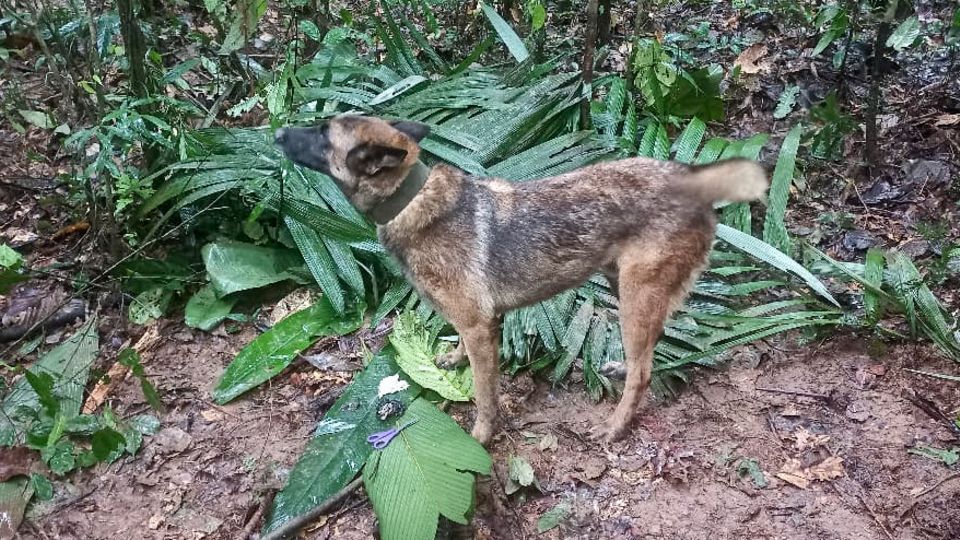Colombia
Search parties find new traces of the children who have been missing for weeks
About a month after this Cessna C206 crashed in the Solano jungle in the Colombian state of Caqueta, rescue workers are still searching for children who were lost in the jungle
© Colombia’s Armed Forces Press Office / DPA
Soldiers and indigenous people have been combing the rainforest for weeks in search of four children. You’ve already found sneakers, diapers and a bottle – and now a small footprint.
It’s actually hard to believe: For a month now, four children have been trying to fend for themselves in the Colombian jungle. After a plane crash, emergency services are feverishly looking for the siblings aged 13, 9 and 4 years and one year old. In the meantime there are even reports of a rescue of the four. Reports that turn out to be wrong a little later.
But now soldiers have a new lead. The search teams found broken branches and open food packages, a military spokesman said on Tuesday (local time) on the Caracol television station. A footprint found in the mud could belong to the 13-year-old girl. “The search has not stopped and we continue to hope to find the children using satellites that will provide guidance to soldiers and indigenous people in the area,” the armed forces wrote on Twitter.
Again and again traces of the children in the jungle
The siblings crashed on May 1 with a Cessna 206 propeller plane in the Caquetá department in the south of the country. Her mother, the pilot and an indigenous leader died in the accident. While searching for the children, the soldiers found shoes, diapers, hair ties, purple scissors, a baby bottle, a shelter built from leaves and branches, and half-eaten fruit. “We have to find them,” General Pedro Arnulfo Sánchez, commander of the “Operation Hope” search operation, said in a broken voice on RCN television.
However, the rainforest in the region is very dense, which makes the search for the missing people much more difficult. In addition, it rains almost non-stop. “We think we’re very close to them,” General Sanchez said. “We think we’ve come within 100 meters of them before, but you can’t see more than 20 meters here.”
For weeks, soldiers and indigenous people have been combing an area about the size of the capital, Bogotá. With helicopters and sniffer dogs, they search for the children in the impassable terrain. The search teams struggle with adverse conditions. They have little to eat and are constantly soaked from the constant rain, according to one of the support pilots on TV station Caracol. Videos released by the armed forces showed soldiers fighting their way to the plane wreckage in heavy rain. In another clip, emergency services abseil from a helicopter to a clearing.
The father of the children is also involved in the search. “I’m not feeling well. It’s a hard blow,” said Manuel Ranoque a few days ago at a search team camp in the rainforest. “But I still have hope of being with my children again, with my family. That’s the most important thing.”

Children know their way around the jungle
The children themselves belong to an indigenous community, and their knowledge of the region may have helped them survive in the jungle after the crash. Her grandmother Fátima Valencia mainly trusts her eldest sister. “She was always like her mother, she took the others to the forest,” she said on radio station La FM. “She knows the plants and fruits. We indigenous people learn from an early age which ones are edible and which ones aren’t.”
The case is reminiscent of the German-Peruvian Juliane Koepcke, who survived a plane crash in the Peruvian rainforest in 1971 and was rescued ten days later. Since her parents were biologists researching in the Amazon region, she was familiar with the area and was able to make her way to a river, where she was finally found by forest workers.
Parts of Colombia controlled by FARC
According to media reports, the children in Colombia were with their mother on the way to their father, who had fled the region after constant threats from a splinter group of the guerrilla organization FARC. Although the security situation has improved after the 2016 peace agreement between the government and FARC, parts of the South American country are still controlled by illegal groups. Indigenous peoples, social activists and environmentalists in particular are repeatedly targeted by criminal gangs.
“Maybe they are scared and hiding,” the children’s grandfather, Fidencio Valencia, told Caracol TV channel, citing his grandchildren’s bad experiences with armed groups. “They may not know they are being searched for, or they may fear something might be done to them.”
In order to allay the children’s fear, the soldiers now play back a message recorded by the grandmother in her indigenous language. “I’m your Grandma Fátima, you understand me,” says the recording, which echoes through the jungle from loudspeakers. “Keep calm. They’re looking for you. Listen to the microphone, stay where you are so they can get you.”

